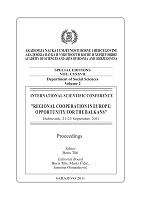INSTITUTIONAL CAPACITY AND REGIONAL ELECTRICITY MARKET IN SOUTHEAST EUROPE
INSTITUTIONAL CAPACITY AND REGIONAL ELECTRICITY MARKET IN SOUTHEAST EUROPE
Author(s): Nela Vlahinić-Dizdarević, Saša Žiković
Subject(s): Economy, Energy and Environmental Studies, International relations/trade, EU-Approach / EU-Accession / EU-Development, ICT Information and Communications Technologies
Published by: Akademija Nauka i Umjetnosti Bosne i Hercegovine
Keywords: institutional capacity; Southeast Europe; regional electricity market; regulation;
Summary/Abstract: The implementation and benefits of regional electricity market (REM) in Southeast strongly depend on institutional capacity in these economies. At the same time, the appropriate level of institutional resources is crucial for SEE countries in order to benefit from the REM. The first step of institutional reforms is the establishment of national regulatory agency in the field of energy. All SEECs have adopted the EU reform model and established formally independent regulatory agencies, but the same model copied on those implemented in developed economies obviously is not a guarantee for an effective regulatory process. The failure of regulation in many less developed countries is the result of underestimation of the importance of the institutional capacity and institutional differences across countries, while the process of unbundling has made the regulatory task even more complex. The barriers for the regulator’s independency can be related to a shortage in human and administrative resources, a lack of political support for the reforms and regulator’s close connections to regulated industry. The second step of institutional reforms necessary for building REM considers regional cooperation and regional institutional activities. SEE countries have implemented the harmonized, uniform approach influenced by EU Directives in the energy sector and this approach requires extensive subordination of national interests. Harmonization is especially important in order to attract private investors because they will invest only if there is a high degree of certainty about transmission network access, regulatory transparency and predictability. Therefore the common regulatory framework within the region with the coordination of regional planning would create benefits for all the SEE countries.
Book: INTERNATIONAL SCIENTIFIC CONFERENCE - REGIONAL COOPERATION IN EUROPE: OPORTUNITY FOR THE BALKANS
- Page Range: 191-203
- Page Count: 13
- Publication Year: 2011
- Language: English
- Content File-PDF

